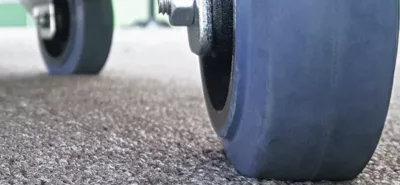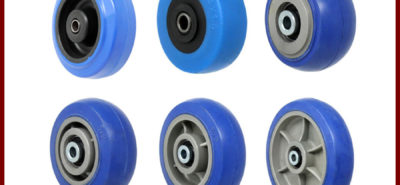What to Look for in Heavy Duty Casters
Choosing the right heavy-duty casters for your industrial needs can be a daunting task, but it doesn’t have to be. This article will help you navigate factors you need to consider when choosing industrial casters.
Caster Types

There are three main types of industrial casters: swivel, rigid, and pneumatic. Each of these types of casters will help you get the job done, but there are a few things to consider when choosing one over another.
Swivel Casters
Swivel casters are the most common type of caster and are ideal for use on smooth surfaces. Swivel casters have a 360-degree range of motion and allow their object to be turned in a complete circle. Due to superior maneuverability, swivel casters are great for moving equipment. They are commonly used to move items such as desks, tables, and chairs.
Rigid Casters
Rigid casters have a limited range of motion and are best suited for use on rough or uneven surfaces. Rigid casters are less expensive than swivel casters and are often used to move large, heavy equipment. Since they are designed to handle a great deal of weight and are noted for durability, rigid casters are often found on equipment used in the construction industry and other industries that require extended use.
Pneumatic Casters
Pneumatic casters are a type of caster that uses air pressure to create a soft, cushioning effect. This makes them ideal for use on delicate floors or in areas where vibration is an issue. When choosing pneumatic casters, it is important to consider the load capacity and inflation pressure. Pneumatic casters are wheels that are inflated with air in order to provide cushioning and shock absorption. Rigid casters are often used on chairs, carts, and other furniture to make them easier to move around.
Caster Materials

Casters are made with a variety of materials, including steel, rubber, and plastic. Each material has its own advantages and disadvantages. For example, plastic casters are more affordable than other types but aren’t as durable as steel casters. Steel casters tend to be the most expensive but are also the most durable.
Caster Weight Capacity
When it comes to choosing industrial/heavy-duty casters, one of the most important factors to consider is the caster weight capacity. This will determine how much weight the caster can support and is therefore an important factor in ensuring that your equipment and materials are moved safely and securely.
To determine the weight capacity of a caster, take into account the materials with which the caster is made, as well as the caster dimensions. The size of the caster will affect how much weight it can support, as well as the type of materials used. For example, a forged steel caster will be able to support more weight than a soft rubber one. In addition, you need to consider the environment in which the caster will be used.
There are a few different ways to determine the weight capacity of a caster. The first is by looking at the manufacturer’s specifications. This will give you a good idea of what the maximum weight capacity of the caster is.
A more informal method is to do a test run. This involves putting some weight on the caster and seeing how it handles it. This can be done with a piece of equipment or material that you intend to move with the caster.
Once you have determined the weight capacity of the caster, make sure that it is suitable for the equipment or materials that you will be moving. If you are moving heavy equipment, make sure that the caster can support its weight. If you are moving delicate materials, be certain that the caster will not damage them.

Caster Size
Next, when choosing an industrial also known as a heavy-duty caster, you need to consider its size. The size of the caster needs to be appropriate for the space in which it will be used. Choosing a caster for a small space can be tricky. You want to make sure that the caster is small enough to fit in the space, but also that it is durable and can hold up to whatever you will be using it for.
Surface Requirements
When it comes to choosing heavy-duty casters, the next factor to consider is surface requirements. What type of surface will the heavy-duty caster be rolling on? Is it a smooth concrete floor or an uneven outdoor surface? The answer to this question will determine the type of wheel you need.
If you’ll be using your industrial casters on a smooth, level surface like a concrete floor, then you can choose from a variety of wheel materials including nylon, urethane, and steel. These materials all have different benefits and drawbacks that you’ll want to consider before making your final decision.
Nylon heavy-duty caster wheels are very popular because they’re inexpensive and they offer good traction. However, they’re not as durable as other wheel materials and they can’t handle heavy loads. Urethane wheels are more expensive than nylon wheels but they’re much more durable. They’re also great for use on uneven surfaces because they offer good shock absorption. Steel wheels are the most expensive option but they’re also the most durable. They can handle heavy loads and they’re great for use on both smooth and uneven surfaces.
No matter what type of wheel material you choose, make sure it’s compatible with the surface you’ll be using it on. Otherwise, you won’t get the results you’re looking for and your industrial casters won’t last as long as they should.
Brake Requirements
Another important factor to consider is brake requirements. The brakes on your caster must be able to handle the weight and load of your application. You can find this information in your caster’s manual. There are two types of brakes – hydraulic and mechanical. Mechanical brakes are often used on lightweight industrial casters while hydraulic brakes are more suitable for heavy-duty applications.
Another factor to consider when deciding brake requirements is the environmental conditions where the caster will be used. If you will be using the caster in a wet or corrosive environment, you need to make sure the brake is made for that type of environment. For example, if the caster will be used in a wet area, it’s best to choose a brake that is sealed. Sealed brakes are designed not to allow water inside so they can operate properly and safely in wet conditions.
Conclusion

When it comes to choosing the right industrial casters for your business, there are several factors you need to consider. While the task may seem overwhelming, it doesn’t have to be. By taking the time to evaluate your specific needs, you can choose the best industrial caster for your business.





